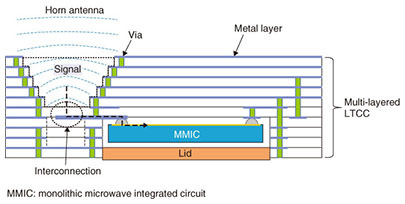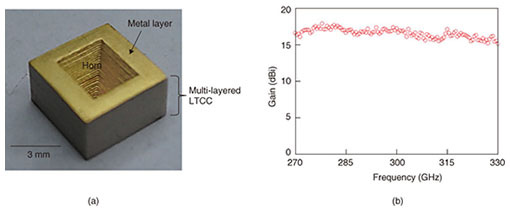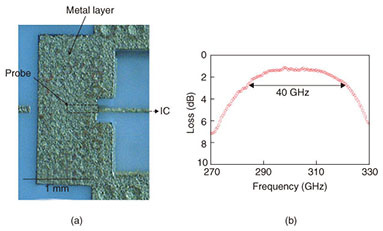 |
|||||||
|
|
|||||||
|
Feature Articles: R&D on Devices Using Life-assist Technologies Vol. 13, No. 1, pp. 35–41, Jan. 2015. https://doi.org/10.53829/ntr201501fa6 Terahertz Device Technologies for Ultrafast Data Downburst ApplicationsAbstractAdvances in medical imaging technology such as computed tomography and magnetic resonance imaging have made it possible to capture minute defects inside the human body. Correspondingly, the volume of such imaging data has been dramatically increasing. There is also a demand to access such medical data using mobile terminal devices. To accommodate this demand, a wireless system with extremely high throughput of 100 Gbit/s or more is essential to enable instant data downloading. In this article, we give an overview of recent progress in terahertz communications, particularly in front-end technologies, which hold high promise for realizing future ultrafast wireless link applications. Keywords: ultrafast wireless communications, terahertz wave, terahertz communications 1. IntroductionSteady progress is continuously being made in ICT (information and communication technology), and this has led to substantial changes in hospitals and in the healthcare field in general. Medical records including computed tomography (CT) and magnetic resonance imaging (MRI) data, which were initially in the form of paper documents, are now translated into electrical signals and recorded digitally in electronic medical records (EMRs). Doctors can look through the medical data via a mobile terminal such as a tablet computer or smartphone anywhere and diagnose and treat their patients remotely. The use of the EMR and telemedicine system will not only improve medical services in quality but also lead to new ones. The quality of medical services is also being improved with the advances in medical instruments and equipment. For instance, state-of-the-art medical imaging systems can detect tiny defects and abnormalities in the human body, which used to be difficult to detect. These advances, especially in the resolution of medical imaging instruments, have led to an explosive increase in the volume of medical data, which has consequently created problems in managing, maintaining, and storing the EMRs. When a CT image is taken of the area from the chest to the abdomen with 0.5 mm resolution, approximately 2000 fragments of CT images are produced that require about 1 GB of storage per patient. In view of the fact that CT is now widely and frequently used in hospitals, one can easily estimate that several hundreds of gigabytes of medical data are generated by a CT machine in a single day. The volume of a person’s EMRs if he/she had a regular medical check in the last ten years would be at least 10 GB, and probably much more. Unfortunately, however, the existing wireless data transmission systems are not fast enough to deal with the medical data commonly used these days and may even cause degradation of service quality. We review in this article the recent progress achieved in an ultrafast wireless system we are developing called data downburst, which can transmit a huge amount of medical data instantaneously by utilizing the huge bandwidth of terahertz waves. 2. Terahertz wirelessTo achieve ultrafast throughput of 100 Gbit/s or more, we focused on the terahertz frequency band, which is located between the microwave and far-infrared light-wave bands in the electromagnetic spectrum [1]. In terms of frequency, it is defined as 100 GHz to 10 THz in general and is frequently referred to as the terahertz gap or the forbidden region because of the huge technical barriers in generating and detecting signals at these high frequencies. The conductivity of metals usually used for signal wires or waveguides gradually degrades as the frequency increases, resulting in large signal loss at terahertz frequencies. Because of this, many terahertz signal generators produce very weak signals or are usually operated at impractically low temperatures at around −196°C or even below. Though high power of 1 W or more can be technically generated at terahertz frequencies, it requires a generator so large it would fill a room. Despite these technical difficulties, the inherently large bandwidth of terahertz waves is believed to be the only means to achieve the 100-Gbit/s wireless system. The frequency is approximately 100 times higher than that of microwaves, which the current wireless system operates at, and the available bandwidth is also that much larger. In 2009, we first proved the effectiveness of the terahertz wave for a large data rate wireless system by experimentally demonstrating 8-Gbit/s data transmission at terahertz frequencies even with a weak power signal emitter, poor sensitivity receiver, and no signal processing. By improving the bandwidth of the devices used in the feasibility test, we were able to increase the maximum data rate up to 24 Gbit/s, which is approximately five times higher than the newest USB (universal serial bus) wire connection technology. These demonstrations clearly showed how the large bandwidth is important to obtain a high data rate in wireless communications systems. Since then, we have continued to investigate and develop functional radio frequency (RF) front-end component integrated circuits (ICs) based on semiconductor devices that are necessary for practical systems in terms of cost, size, and power consumption. The results we have achieved have greatly influenced the global movement toward standardization in the Institute of Electrical and Electronics Engineers (IEEE) for 100-Gbit/s wireless communications systems. 3. Terahertz ICs in 300-GHz bandThe composition of the RF front end for terahertz communications systems is basically similar to that of conventional radio systems that consist of amplifiers, modulator/demodulators, local oscillators, and other components. However, the design considerations for the RF front end and component ICs operating at terahertz frequencies are quite different from those for the microwave frequency band because of the large loss and large bandwidth. For example, forward microstrip lines exhibit lower conductive loss but require an inductive inter-layer via between the transistors and signal lines, which leads to inductive signal loss. In contrast, the inverted microstrip lines, in which the signal line is located in the bottom layer, do not require the interlayer via, although the overall conductive loss is quite high due to the thin signal line. On the basis of these design considerations, we have designed important front-end components such as an amplifier, oscillator, and quadrature phase shift keying (QPSK) modulator and demodulator at 300 GHz, where the first atmospheric window is located. These were fabricated using state-of-the-art compound semiconductor transistor technologies of which the cut-off frequency (fmax) is approximately 650 GHz. A photo of a fabricated 300-GHz three-stage amplifier in cascode configuration is shown in Fig. 1 along with a schematic diagram for a single stage and the measured gain and noise figure characteristics. The measured small-signal gain and bandwidth are approximately 28 dB at the center frequency and a 10% bandwidth at a single power supply of 3.3 V and total current of around 80 mA. The measured noise figure in the operating bandwidth at around 300 GHz is approximately 10–12 dB, which is the lowest ever reported at these high frequencies. It is most likely also due to the minimized signal loss in the circuit achieved by proper selection of the transmission lines.
A voltage controlled oscillator (VCO) is another important RF block used to generate the terahertz signals on which data will be carried. A photo of a fabricated VCO is shown in Fig. 2, as well as the measured spectrum and time-domain traces of outputs. For the design of the oscillator, we selected the common-collector Colpitts topology because of its simple configuration, which helps to avoid signal loss from the circuit complexity. In addition, for the QPSK modulation scheme, the VCO was designed to have four outputs of which the phase states are at 0°, 90°, 180°, and 270°, which is generally called a quadrature VCO. We achieved this by cross-locking two identical oscillators by forcing a node on the symmetry line in the circuit in the in-phase at the second harmonic frequency. The two unit oscillators should be as close as possible, so we employed the inverted microstrip lines, which are advantageous in loss for short distances. As a result, the single-mode oscillation and quadrature signal generation is clearly shown in Fig. 2. To the best of our knowledge, this is the first successful demonstration of a quadrature VCO in the 300-GHz frequency band in the world. The phase noise, which is the figure of merit that implies frequency stability of an oscillator, was measured to be approximately –90.4 dBc/Hz at a 10-MHz offset frequency, which is sufficient for QPSK modulation.
To generate and detect QPSK signals, we selected a direct conversion scheme rather than the heterodyne configuration commonly used in many radio systems. Terahertz communications utilize large bandwidth, so a direct conversion scheme is advantageous for handling a large bandwidth signal with no signal distortion. Photos of the fabricated QPSK modulator and demodulator are shown in Fig. 3. As can be seen, two different transmission lines—forward and inverted microstrip lines—were simultaneously adopted in the design. Passive components for balanced signaling are implemented with the forward microstrip lines and can thus be seen clearly, while core parts implemented with the inverted microstrip lines are not seen due to the topmost metal used as a ground plane.
To examine the maximum data rate which the modulator and demodulator can operate at, we prepared a test IC in which the modulator and demodulator were directly connected by the short forward microstrip line and performed back-to-back tests at up to 60 Gbit/s. The measured eye diagrams of the demodulated signals at several data rates are shown in Fig. 4. As can be seen, at up to 50 Gbit/s, the eye diagrams are clear and open, and the bit error rate is on the order of 10−8 or lower. Although it is half the goal we are aiming for, the 50 Gbit/s is more than ten times faster than the fastest existing wireless system and is as fast as it takes to completely download a single DVD (digital versatile disc) movie in a second.
4. 300-GHz horn antenna integrated in LTCC packageThe terahertz package in a terahertz wireless front-end module must have an antenna to radiate or capture wireless signals and an interconnection to connect the antenna and RF frond-end ICs to be installed in the package. In the terahertz band, as the wavelength gets shorter, it becomes possible to miniaturize the antenna and package. A compact and low cost terahertz package enables the development of a front-end module that can be embedded into tablet computers and smartphones. However, conventional terahertz modules are metal packages with a silicon lens antenna on which the IC is directly attached with precise alignment. These packages are expensive, and it is difficult to implement interconnection to the IC with them. Therefore, we developed a 300-GHz package integrated with a horn antenna by utilizing the ceramic material known as low temperature co-fired ceramics (LTCC), which is used in microwave and millimeter-wave packages [2]. A cross-sectional view of the proposed terahertz package is illustrated in Fig. 5. Integrating the antenna into the package not only makes it possible to integrate the terahertz IC, power source, and high-density signal line but also to miniaturize the antenna and the interconnection. Furthermore, it resolves the issue of interconnection and low cost for high-volume production.
A prototype of the antenna using LTCC multi-layered substrates is shown in Fig. 6. The horn antenna is shaped by gradually widening the cavity surrounding the vias and metal layers. The antenna is around 5 × 5 × 3 mm in size. Despite the antenna’s compactness, its gain is 15 dBi or more, and the bandwidth is more than 60 GHz. An interconnection between the antenna and IC was also developed using LTCC multi-layered substrates [3]. A probe was placed in the waveguide formed in the LTCC to effectively couple the electromagnetic wave propagating in the waveguide and convert the propagation mode of the waveguide into the propagation mode of the microstrip line that connects to the IC. A prototype of the interconnection using LTCC multi-layered substrates is shown in Fig. 7. The size of the interconnection is around 1 × 1 × 0.3 mm. The insertion loss is less than 3 dB, and the bandwidth is around 40 GHz. We aim to develop a compact and low-cost terahertz front-end module by integrating these components into a single package with a terahertz IC.
5. Conclusion and future perspectiveIn the history of progress achieved in wireless communications technologies, the advances in terms of data rate in the last few years have been much greater than those during the first 100 years, but the speed of progress is not fast enough to accommodate the demand from users, which is explosively increasing. This is because the operating frequencies of wireless systems are still in the microwave frequencies, where bandwidth is inherently limited. At this time, one may think the use of terahertz waves, of which the frequency is 100 times higher than that of the microwave band, for wireless communications is technically nonsense. However, when we consider that the amount of digital information generated is exponentially increasing day by day, and recent new industries related to big data and cloud computing will accelerate the increase further, it is not difficult to estimate that the large bandwidth in the terahertz wave band will be necessary in the next ten years. We have taken a future perspective and have developed several RF front-end components including an amplifier, oscillator, and modulator/demodulator for future terahertz communications at 300 GHz. We have also demonstrated the successful operation of 300-GHz QPSK ICs at data rates up to 50 Gbit/s, which is ten times faster than current state-of-the-art wireless systems. In addition, we investigated compact packaging technology for practical use. These results indicate the great potential of terahertz waves for use in future ultrafast data downburst systems providing data rates of 100 Gbit/s or more. AcknowledgementThis work was supported in part by the research and development program on ‘Multi-tens gigabit wireless communication technology at sub-terahertz frequencies’ of the Ministry of Internal Affairs and Communications, Japan. References
|
|||||||


















